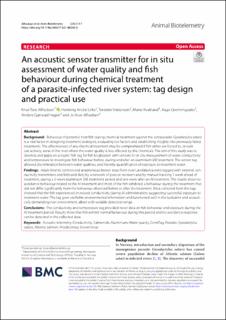| dc.contributor.author | Alfredsen, Knut | |
| dc.contributor.author | Urke, Henning Andre | |
| dc.contributor.author | Kristensen, Torstein | |
| dc.contributor.author | Kvakland, Marte | |
| dc.contributor.author | Grønningsæter, Åge | |
| dc.contributor.author | Hagen, Anders Gjørwad | |
| dc.contributor.author | Alfredsen, Jo Arve | |
| dc.date.accessioned | 2021-07-15T14:22:12Z | |
| dc.date.available | 2021-07-15T14:22:12Z | |
| dc.date.created | 2021-02-05T08:50:35Z | |
| dc.date.issued | 2021 | |
| dc.identifier.citation | Animal Biotelemetry. 2021, 9 (7). | en_US |
| dc.identifier.issn | 2050-3385 | |
| dc.identifier.uri | https://hdl.handle.net/11250/2764571 | |
| dc.description.abstract | Behaviour of potential host fish during chemical treatment against the ectoparasite Gyrodactylus salaris is a vital factor in designing treatment strategies, evaluating risk factors and establishing insights into previously failed treatments. The effectiveness of any chemical treatment may be compromised if fish either are forced to, or seek out actively, areas of the river where the water quality is less affected by the chemicals. The aim of this study was to develop and apply an acoustic fish tag for fish localization with sensors for in situ measurement of water conductivity and temperature to investigate fish behaviour before, during and after an aluminium (Al) treatment. The sensor tag allowed discrimination between water qualities, and thereby quantification of exposure to treatment water.
Findings
Adult Atlantic salmon and anadromous brown trout from river Lærdalselva were tagged with external conductivity transmitters and followed daily by a network of passive receivers and by manual tracking 1 week ahead of treatment, during a 2-week aluminium (Al) treatment period and one week after an Al treatment. The results show no avoidance behaviour related to the Al treatment and most of the fish exhibited a behaviour during the treatment that did not differ significantly from the behaviour observed before or after the treatment. Data collected from the tags showed that the fish experienced increased conductivity during Al administration, suggesting successful exposure to treatment water. The tag gave verifiable environmental information and functioned well in the turbulent and acoustically demanding river environment, albeit with variable detection range.
Conclusions
The conductivity and temperature tag provided novel data on fish behaviour and exposure during the Al treatment period. Results show that fish exhibit normal behaviour during this period and no avoidance response can be detected in the collected data. | en_US |
| dc.language.iso | eng | en_US |
| dc.publisher | BMC | en_US |
| dc.relation.uri | https://rdcu.be/ceNe2 | |
| dc.rights | Navngivelse 4.0 Internasjonal | * |
| dc.rights.uri | http://creativecommons.org/licenses/by/4.0/deed.no | * |
| dc.title | An acoustic sensor transmitter for in situ assessment of water quality and fish behaviour during chemical treatment of a parasite-infected river system: tag design and practical use | en_US |
| dc.type | Peer reviewed | en_US |
| dc.type | Journal article | en_US |
| dc.description.version | publishedVersion | en_US |
| dc.rights.holder | © The Author(s) 2021. | en_US |
| dc.source.pagenumber | 13 | en_US |
| dc.source.volume | 9 | en_US |
| dc.source.journal | Animal Biotelemetry | en_US |
| dc.source.issue | 7 | en_US |
| dc.identifier.doi | 10.1186/s40317-021-00230-6 | |
| dc.identifier.cristin | 1886974 | |
| cristin.ispublished | true | |
| cristin.fulltext | original | |
| cristin.qualitycode | 1 | |

